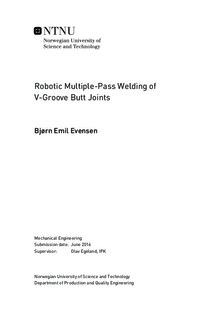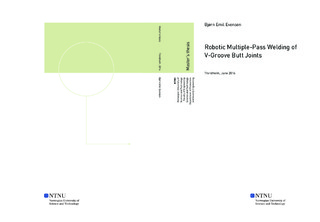| dc.description.abstract | Intelligent and automated production have become an inevitable trend for manufacturing companies in developed countries. Robotic welding is a key component in order to ac- complish a competitive and effective production. Successful implementation of robotic welding is especially seen throughout the automobile industry. However, other industries are still on the verge of utilizing robotic welding. One of them is the offshore sector. Offshore structures are large constructions welded together by minor components. An ex- ample of this is ships, assembled by thick plates welded together end-to-end. To ensure sufficient strength in the welded joints, full penetration welds are needed and a multiple-pass weld sequence is required. Multiple-pass welding is generally done manually as the process is complex and difficult to automate.
This thesis presents an automated solution for multiple-pass welding of thick V-groove butt joints with variable geometry. This welding configuration is common in shipbuilding and in fabrication of high pressure vessels. Previous research on automated multiple-pass planning have been reviewed and used as a basis for the solution presented in this thesis. A procedure that determines a welding sequence containing the number of layers and passes based on geometrical properties of a butt joint, is created using different programming and simulation software. Weld beads are approximated as sets of parallelograms and trapeziums. Algorithms in this procedure calculates the position and pose of the welding torch, amplitude of weaving and the number of passes for each layer based on a set of parameters and criteria. These are welding speed, filler wire feed speed, maximum amplitude of weaving and maximum allowed bead height. A robot program is then created for execution of the welding sequence.
The procedure have been implemented in the robotics laboratory at the Institute of Production and Quality Engineering, NTNU. This implementation showed the effective- ness of the automated procedure by successfully welding different V-groove butt joints. A set of preliminary tests were conducted to determine viable combinations of welding parameters. Continuous testing was then carried out to adjust the deposition efficiency coefficient and the weaving factor. In the end, conformity between the procedure and the experimental results was obtained. The results from all welding experiments are presented in the thesis. | |

